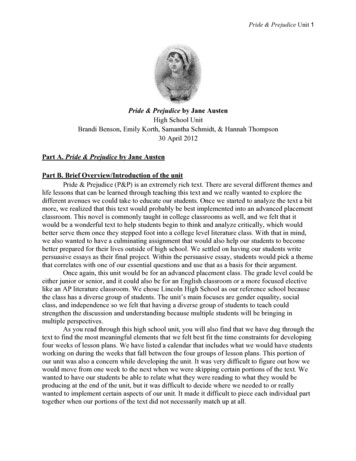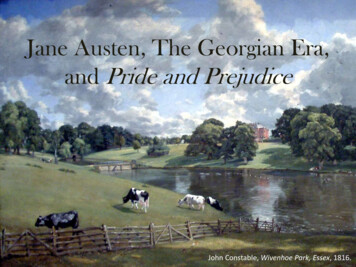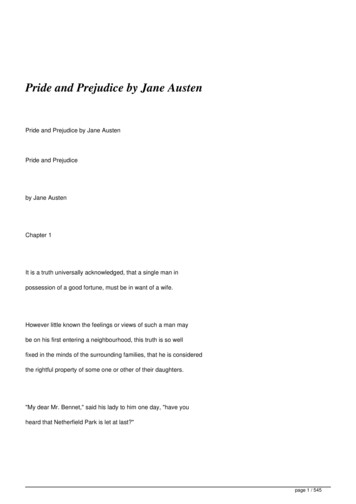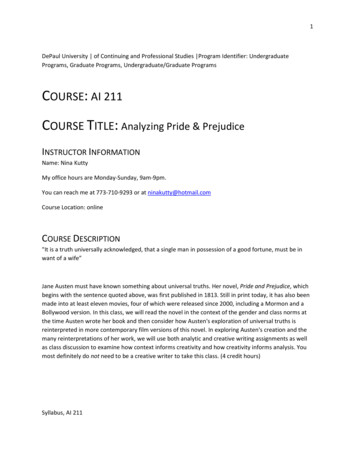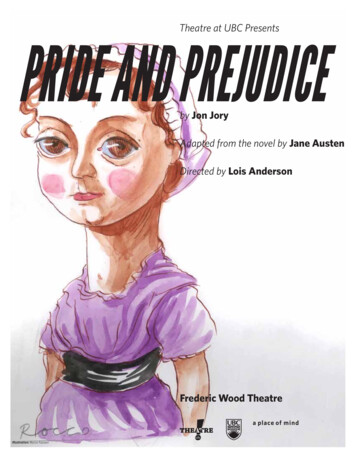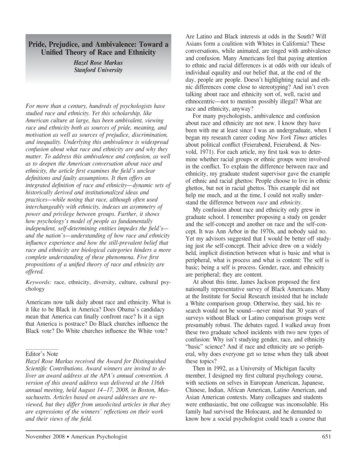
Transcription
Pride, Prejudice, and Ambivalence: Toward aUnified Theory of Race and EthnicityHazel Rose MarkusStanford UniversityFor more than a century, hundreds of psychologists havestudied race and ethnicity. Yet this scholarship, likeAmerican culture at large, has been ambivalent, viewingrace and ethnicity both as sources of pride, meaning, andmotivation as well as sources of prejudice, discrimination,and inequality. Underlying this ambivalence is widespreadconfusion about what race and ethnicity are and why theymatter. To address this ambivalence and confusion, as wellas to deepen the American conversation about race andethnicity, the article first examines the field’s uncleardefinitions and faulty assumptions. It then offers anintegrated definition of race and ethnicity— dynamic sets ofhistorically derived and institutionalized ideas andpractices—while noting that race, although often usedinterchangeably with ethnicity, indexes an asymmetry ofpower and privilege between groups. Further, it showshow psychology’s model of people as fundamentallyindependent, self-determining entities impedes the field’s—and the nation’s— understanding of how race and ethnicityinfluence experience and how the still-prevalent belief thatrace and ethnicity are biological categories hinders a morecomplete understanding of these phenomena. Five firstpropositions of a unified theory of race and ethnicity areoffered.Keywords: race, ethnicity, diversity, culture, cultural psychologyAmericans now talk daily about race and ethnicity. What isit like to be Black in America? Does Obama’s candidacymean that America can finally confront race? Is it a signthat America is postrace? Do Black churches influence theBlack vote? Do White churches influence the White vote?Editor’s NoteHazel Rose Markus received the Award for DistinguishedScientific Contributions. Award winners are invited to deliver an award address at the APA’s annual convention. Aversion of this award address was delivered at the 116thannual meeting, held August 14 –17, 2008, in Boston, Massachusetts. Articles based on award addresses are reviewed, but they differ from unsolicited articles in that theyare expressions of the winners’ reflections on their workand their views of the field.November 2008 American PsychologistAre Latino and Black interests at odds in the South? WillAsians form a coalition with Whites in California? Theseconversations, while animated, are tinged with ambivalenceand confusion. Many Americans feel that paying attentionto ethnic and racial differences is at odds with our ideals ofindividual equality and our belief that, at the end of theday, people are people. Doesn’t highlighting racial and ethnic differences come close to stereotyping? And isn’t eventalking about race and ethnicity sort of, well, racist andethnocentric—not to mention possibly illegal? What arerace and ethnicity, anyway?For many psychologists, ambivalence and confusionabout race and ethnicity are not new. I know they havebeen with me at least since I was an undergraduate, when Ibegan my research career coding New York Times articlesabout political conflict (Feierabend, Feierabend, & Nesvold, 1971). For each article, my first task was to determine whether racial groups or ethnic groups were involvedin the conflict. To explain the difference between race andethnicity, my graduate student supervisor gave the exampleof ethnic and racial ghettos: People choose to live in ethnicghettos, but not in racial ghettos. This example did nothelp me much, and at the time, I could not really understand the difference between race and ethnicity.My confusion about race and ethnicity only grew ingraduate school. I remember proposing a study on genderand the self-concept and another on race and the self-concept. It was Ann Arbor in the 1970s, and nobody said no.Yet my advisors suggested that I would be better off studying just the self-concept. Their advice drew on a widelyheld, implicit distinction between what is basic and what isperipheral, what is process and what is content: The self isbasic; being a self is process. Gender, race, and ethnicityare peripheral; they are content.At about this time, James Jackson proposed the firstnationally representative survey of Black Americans. Manyat the Institute for Social Research insisted that he includea White comparison group. Otherwise, they said, his research would not be sound—never mind that 30 years ofsurveys without Black or Latino comparison groups werepresumably robust. The debates raged. I walked away fromthese two graduate school incidents with two new types ofconfusion: Why isn’t studying gender, race, and ethnicity“basic” science? And if race and ethnicity are so peripheral, why does everyone get so tense when they talk aboutthese topics?Then in 1992, as a University of Michigan facultymember, I designed my first cultural psychology course,with sections on selves in European American, Japanese,Chinese, Indian, African American, Latino American, andAsian American contexts. Many colleagues and studentswere enthusiastic, but one colleague was inconsolable. Hisfamily had survived the Holocaust, and he demanded toknow how a social psychologist could teach a course that651
he called Stereotyping 101. My head hurt: As a social psychologist, I shared my field’s passion for drawing attentionto the evils of prejudice and discrimination. But also as asocial psychologist, I shared my field’s passion for identifying patterns in social behavior. Where did science endand stereotyping begin?Grappling with race and ethnicity caused me problemsagain in 1995. My research lab was discussing the powerof popular media to create and maintain stereotypes. I wasarguing that Pocahontas (Pentecost, Gabriel, & Goldberg,1995), unlike earlier Disney movies, included some positive representations of underrepresented minorities. AnAmerican Indian student retorted, “White people wouldthink that.” I was used to push-back in this lab, but I wassurprised to hear myself called a White person. After allthese years studying race and ethnicity, I had somehowfailed to realize that I “have” race, too. Moreover my observation that things were getting better for American Indians was experienced as reflecting this White perspective.More recently, I discovered that the struggle over whatto think, say, and do about race and ethnicity is pouredinto the very concrete of my office. The Stanford Psychology Department resides in a building named after DavidStarr Jordan, the first president of Stanford and, like manyeducational leaders of his time, a noted eugenicist. Overthe building’s entryway is a statue of Louis Agassiz, aSwiss American naturalist, champion of the scientificmethod, highly accomplished Harvard professor, and proponent of the belief that some races are just biologicallybetter than others. How is it that Jordan Hall, home to generations of scientists trying to counter prejudice, stereotyping, and discrimination, features the name and image oftwo people whom some might now call racists? What dowe do about the Jordan name, the Agassiz statue?My confusion and ambivalence about race and ethnicitydo not stem from a lack of interest, effort, or goodwill.They are also not mine alone. Instead, they reflect the assumptions and anxieties of the field of psychology, whichin turn embodies the assumptions and anxieties of Americans as a whole.With race and ethnicity moving to the fore of our nation’s consciousness, the time has come for psychologiststo examine our own ambivalence and confusion so thatwe may spell out, clearly and compellingly, what race andethnicity are and why they matter for behavior. Here I offer a first step toward that end: the beginnings of a unifiedtheory of race and ethnicity. I first argue that psychology’sambivalence and confusion stem from four sources: (a)disagreements over the definitions of race and ethnicity, (b)a view of the person that inhibits our ability to understandhow race and ethnicity might shape experience, (c) thestubborn persistence of the idea that race and ethnicity arebiological categories, and (d) psychology’s inattention toits own role in fostering this ambivalence. I then offer new652definitions of race and ethnicity and describe a view of theperson that readily accounts for how race and ethnicityinfluence behavior.Finally, I sketch five initial propositions of a unifiedtheory of race and ethnicity. A complete theory will require multiethnic, multiracial networks of psychologistswith expertise in psychology, in race and ethnicity, and inthe social histories of these phenomena both in Americaand in a global context. In the meantime, closely examining and integrating the psychological research on race andethnicity will be extremely valuable for psychological science and practice.Separate but Relevant LiteraturesMy sense that the time is right for an integration of research on race and ethnicity within psychology developedwhen I was director of the Center for Comparative Studiesin Race and Ethnicity at Stanford University. In my workwith colleagues from many fields, I have noticed that psychologists are more likely to accept race and ethnicity asfacts of the world than are many other scholars. As a field,we have done a good job discovering the universal causesand consequences of prejudice but not such a great jobuncovering the history and specifics of the American case.We are less likely to ask what race and ethnicity are,where they came from, and what psychology has done tocreate and perpetuate particular understandings of thesephenomena (for a significant recent exception, see Helms,Jernigan, & Mascher, 2005). With respect to ethnicity, wehave shown increasing interest in comparing Americanswith Japanese, Chinese, and Koreans or with Asian American or Latino American participants, and in characterizingdifferences among these groups in various psychologicaltendencies. At the same time, we have been much less astute in recognizing that “everyone is ethnic” and in examining how mainstream European American behavior is alsoethnically and racially grounded.Within psychology, researchers across subfields studyrace and ethnicity, generating a variety of distinct literatures that could be well integrated. One robust, empiricalliterature now demonstrates that race shapes psychologicalexperience (for reviews see, e.g., Adams, Biernat,Branscombe, Crandall, & Wrightsman, 2008b; Cuddy,Fiske, & Glick, 2007; Dovidio & Gaertner, 2004; Eberhardt & Goff, 2005; Greenwald & Banaji, 1995; Jackson,Chatters, & Taylor, 2004; J. M. Jones, 1997; Major &O’Brien, 2005; Richeson & Shelton, 2007; C. M. Steele,1997). We now know from this research that racial identitycan be an important predictor of attitudes, beliefs, motivation, and performance. In contrast to conventional wisdom,racial identity need not pose a barrier to finding commonalities with other groups (e.g., Cross, Parham, & Helms,1991; Gurin, Gurin, Matlock, & Wade-Golden, 2008;Helms, 1990; Oyserman, Kemmelmeier, Fryberg, Brosh, &November 2008 American Psychologist
Hart-Johnson, 2003; Sellers & Shelton, 2003). We alsoknow that racial stereotypes are often automatically activated and have powerful behavioral consequences both forthose who hold the stereotypes and for those who are thetarget of them. One groundbreaking theory and finding isthat racial prejudice and discrimination do not require individual negative attitudes or hostile intent. Instead, whatClaude Steele and his colleagues describe as a “threat inthe air”—a stereotype about one’s group that is active inthe sociocultural context—is enough to impair performancein domains relevant to the stereotype (e.g., C. M. Steele, inpress; C. M. Steele, Spencer, & Aronson, 2002).Another robust but separate literature demonstrates thatethnicity (often called culture) shapes individual experience(for reviews see, e.g., Brewer & Yuki, 2007; Bruner, 1990;Chiu & Hong, 2006; Fiske & Fiske, 2007; Greenfield &Cocking, 1994; Heine, 2008; Kim, Sherman, & Taylor,2008; Kitayama & Cohen, 2007; Markus & Hamedani,2007; Markus & Kitayama, 2003b; Matsumoto, 2001; Mesquita & Leu, 2007; Miller, 1999; Nisbett, 2003; Shweder,1991, 2003; Tsai, 2007). Labeled cultural psychology, thisliterature has so far primarily documented diversity in thepsychological functioning of European Americans and EastAsians, even though culture is a more general term andrefers to patterns of ideas and practices associated with anysignificant social grouping, including gender, religion, social class, nation of origin, region of origin, birth cohort, oroccupation. Studies in cultural psychology reveal that muchof what has been taken for granted in the field of psychology as “basic human psychological experience”—for example, ways of attending, thinking, feeling, being a self, relating to others, coping—is actually specific to middle-classEuropean American psychological experience. Japanese,Korean, Chinese, and Asian American contexts are oftencharacterized by different understandings of what is good,real, moral, and healthy, as well as by different social andmaterial resources. As a consequence, the psychologicalprocesses of those engaged in these contexts can take verydifferent forms. The goal of this research is to extend thescope of psychological theories so that they are useful andrelevant to the predictions, descriptions, and explanationsof all human behaviors, not just middle-class, Western ones(Markus & Kitayama, 2003a).A third thriving literature examines both race and ethnicity and how they influence mental health and psychotherapy (for reviews see Draguns & Tanaka-Matsumi,2003; Marsella & Yamada, 2007; Phinney, 1996). Theseanalyses focus on the multiple ways minority and/or immigrant status influence emotional and mental health, and thechallenges of counseling across racial and ethnic divides(Betancourt & Lopez, 1993; Franklin & Boyd-Franklin,2000; Leong et al., 2007; Ponterotto, Casas, Alexander, &Suzuki, 2001; Sue & Sue, 2002). Prior to these comparative studies, racial and ethnic differences in self, emotion,November 2008 American Psychologisthealth, and well-being were like water to the fish—invisible. These studies are also important in highlighting different conditions of societal treatment and integration andtheir consequences for health-related outcomes.A fourth literature that attends to both race and ethnicitycomes from the pioneering work of W. E. B. Dubois andother Black scholars from the early 20th century and fromthe Black psychology movement (Gaines & Reed, 1995).This literature reflects Guthrie’s (1976) observation andbook title that in psychology, Even the Rat Was White.One explicit goal of this research has been to blend perspectives from mainstream research on race, discrimination,and prejudice with research that focuses on the unique historical and cultural experience of African Americans (e.g.,Sellers, Smith, Shelton, Rowley, & Chavous, 1998). Thesestudies examine how African philosophies shape the African American experience. They also analyze concepts thatare meaningful in Black life but that are not represented inmainstream or majority experience (for reviews see Boykin, 1986; J. M. Jones, 2003; R. L. Jones, 1972; Nobles,1972; Taylor & Manning, 1975; White & Parham, 1990).Finally, and more recently, scholars in all of these literatures are seeking ways to integrate perspectives that emphasize the universal aspects of race and ethnicity withperspectives that highlight the ways that psychologicalfunctioning is contingent on history, culture, and context(e.g., Adams, Biernat, Branscombe, Crandall, & Wrightsman, 2008a; Fryberg & Townsend, 2008; J. M. Jones,2003; Kitayama, Markus, Adams, Keller, & Shelton,2008; Oyserman, in press; Purdie-Vaughns, Steele, Davies,Ditlmann, & Crosby, 2008; C. M. Steele, in press; D. M.Steele et al., 2008).Race and Ethnicity DefinedDespite these literatures’ powerful findings and compellinginsights, they have not reached a consensus on what raceand ethnicity are, how they overlap, or how they differ.Instead, race researchers publish their findings in differentjournals and textbooks than do ethnicity or cultural researchers, and the two groups speak at different symposiaand conferences. A quick review of their findings suggeststhat this ambivalence is not surprising. In some instances,racial and ethnic differences are viewed positively: Theyunite people and are a source of pride, identity, and motivation. In other instances, however, the same differencesare viewed negatively: They divide people and are a sourceof prejudice and devaluation. Moreover, research on race isabout countering assumptions of group difference and dispelling stereotypes, whereas research on ethnicity and culture is about identifying and explaining difference and hasbeen accused of generating stereotypes. In addition, African Americans and, more recently, Latino Americans andHispanic Americans are the groups who have “race”;whereas Asians, Asian Americans, and sometimes other653
groups such as the Irish, the Italians, the Mexicans, orAmerican Indians are the groups who have “ethnicity andculture.” Until quite recently, mainstream Whites have hadneither.In fact, most racial or ethnic identifications reflect anongoing confluence of the social structural factors and cultural meanings, and a person’s psychological experiencecannot be parsed easily into its racial or ethnic components. Groups typically conceptualized as races can forsome purposes be “ethnicized” and analyzed as ethnicgroups, and ethnic groups can be “racialized” (as is currently the case for people with Middle Eastern heritage inthe United States, who face increasing discrimination following 9/11) and analyzed as racial groups.Meanwhile, in everyday conversation and in a great dealof social science, medical, and biological research, peopleuse the terms race and ethnicity interchangeably or combine them in constructions such as racial-ethnic or ethnoracial. Both lay people and professionals discuss raceand ethnicity as if they were something people “have”—some set of attributes, traits, properties, or essences. Theythen use these presumed attributes to sort people into different groups.In contrast, scholars in sociology and history have paidmore attention to the difference between race and ethnicity(e.g., Fredrickson, 2002; Omi & Winant, 1986, 1994). According to these views, race implicates power and indexesthe history or ongoing imposition of one group’s authorityover another. Usually, a racial designation signals that differences between groups may be the result of one groupmaintaining another group as different (and usually inferior). Categorizing a group as a racial group draws attention to the difference in the power relationships among thisgroup and other groups. Thus, people in groups calledraces may dispute that they are different from the dominantgroup. In contrast, ethnicity focuses attention on differencesin meanings, values, and ways of living (practices). Peoplein groups called ethnicities are likely to claim these differences and are more likely to agree with generalizationsabout the behavior of the group.Race and ethnicity are, however, alike in many respects,and for this reason, they can be productively consideredtogether. Contrary to the popular belief that race and ethnicity are biological entities, both race and ethnicity aredynamic sets of ideas (e.g., meanings, values, goals, images, associations) and practices (e.g., meaningful actions,both formal and routine) that people create to distinguishgroups and organize their own communities (for relateddefinitions, see Helms, Jernigan, & Mascher, 2005; Kroeber& Kluckhohn, 1952; Phinney, 1996; Shweder, 2003). Thesocial distinctions of race and ethnicity are inventions—theresult of human activity or meaning making, and these aswell as other categorical distinctions, such as gender, religion, social class, nation, and occupation, are not neces654sary, natural, or inevitable. Other distinctions can be madeand will be made as historical, political, and economic conditions change.The existence and influence of race and ethnicity reflecthumans’ unique evolved capacity to make communitiesand then to be shaped by them (Markus & Hamedani,2007). As people ask “Who am I?” they simultaneouslyask “Who are we?” (e.g., Brewer, 2007; Hogg, 2003;Turner & Haslam, 2001). Both ethnicity and race are theresult of the basic psychological process of creating andmaintaining social distinctions. They are both importantanswers to the universal “Who are we?” question, guidingbehavior and sketching blueprints for our worlds. Whetherit is possible to create and observe difference amonggroups of people without establishing a hierarchy, such thatX’s ways of “being” or “doing” are better than Y’s, remains a contested question (Sidanius & Pratto, 1999).The ideas and practices associated with race and ethnicity are not separate from behavior or overlaid on a set ofbasic or fixed psychological processes. Instead, these socialconstructions are active in the very formation and operationof psychological processes. Whether people are aware oftheir race or ethnicity, or whether they claim them as selfdefining, both can influence thoughts, feelings, and actions(Markus, 2008).To capture the important similarities and differencesbetween the terms race and ethnicity, Paula Moya and I ina forthcoming volume (Markus & Moya, in press) offer thefollowing definitions (Moya & Markus, in press):Race is a dynamic set of historically derived and institutionalized ideas and practices that (1) sorts peopleinto ethnic groups according to perceived physical andbehavioral human characteristics; (2) associates differential value, power, and privilege with these characteristics and establishes a social status ranking among thedifferent groups; and (3) emerges (a) when groups areperceived to pose a threat (political, economic, or cultural) to each other’s world view or way of life; and/or(b) to justify the denigration and exploitation (past, current, or future) of, and prejudice toward, other groups.Ethnicity is a dynamic set of historically derived andinstitutionalized ideas and practices that (1) allows people to identify or to be identified with groupings ofpeople on the basis of presumed (and usually claimed)commonalities including language, history, nation orregion of origin, customs, ways of being, religion,names, physical appearance, and/or genealogy or ancestry; (2) can be a source of meaning, action, and identity; and (3) confers a sense of belonging, pride, andmotivation.These definitions highlight that making and maintainingdifference is a social process that involves both ingroupand intergroup relations, and they dispel some of the confusion I have felt in my own career. As an undergraduateNovember 2008 American Psychologist
research assistant whose job was to distinguish betweenracial and ethnic conflicts, I didn’t understand how the difference between ethnic and racial ghettos could be myguide. To my 18-year-old eyes, ethnic ghettos and racialghettos were the same—people with similar languages,customs, and regions of origin living together. Yet historymatters. Ethnic ghettos arise because people choose to bewith others who share their ways of living. But racial ghettos arise when people have no choice in the matter—aswas the case for Jews in Europe during World War II orfor African Americans in the 1960s who were denied mortgages when trying to buy houses in certain neighborhoods.In the latter cases, more powerful groups justified andmaintained the racial ghetto, privileging themselves whileclaiming and fostering the inferiority of the subordinategroup.Highlighting the distinction between race and ethnicityalso clarifies some of my struggles as a graduate studentand faculty researcher. Envision a study comparing Blackand White participants’ political attitudes, coping responses, communication styles, or emotional patterns, asthe Institute for Social Research scholars wanted Jacksonto conduct. Now envision a similar comparison betweenJapanese and European Americans—two ethnic groups thatare relatively similar in power and prestige. In the formercase, one group helped cast the other group as differentand lesser, and so people tend to see the behavior of thedominant group as normative or good and the behavior ofthe subordinate group as nonnormative or deficient. Theymay also fail to link group differences to disparities in resources and opportunities. I see now that Jackson mayhave been worried about comparing Blacks and Whitesbecause he knew that people were unlikely to recognizehow the majority group creates and maintains the Black/White divide. When explaining, say, why Whites votemore often than Blacks, or why White students scorehigher on standardized tests than Black students, some audiences would fail to account for vast differences in thesetwo groups’ histories, resources, and opportunities. Instead,they would fall back on the common just-so story thatBlacks are inferior to Whites—and thereby further justifythe social rankings of Blacks and Whites.When researchers study groups that are similar in powerand prestige, they can more confidently interpret their findings as ethnic differences—that is, differences in ideas,values, and patterns of social life. For example, culturalpsychologists, who have found that middle-class EuropeanAmericans tend to view themselves as influencing otherswhereas middle-class Japanese tend to view themselves asadjusting to others, explain their findings in terms of thedifferent ideas about the self, philosophies, religions, childrearing practices, educational systems, and even languagesof these two groups. These types of ethnic comparisonscan be misleading, however, when the contrast involvesNovember 2008 American Psychologisttwo groups that have experienced different levels of powerand privilege— especially when one has enjoyed its powerand privilege at the expense of the other. In this case, although ethnic comparisons are useful and needed, theyshould be made in tandem with racial comparisons thatexplicitly recognize differences in conceptual and materialresources across time.The Problem With the Independent SelfDefining race and ethnicity highlights two critical featuresof both phenomena— other people create them, and theyare not biologically based “things” that people “have.” Instead, they are socially constructed “doings” or “historically situated projects,” as Omi and Winant (1994, p. 55)call them. Yet the idea of race and ethnicity as socialtransactions is at odds with two powerful cultural assumptions: (a) that the individual is the source of all thought,feeling, and action and (b) that race and ethnicity are biological or otherwise essential attributes (Moya & Markus,in press). These assumptions have considerable historicalprecedent but little empirical support. Nevertheless, theyinvisibly scaffold most conversations on race and ethnicity,driving much of psychology’s—and Americans’— confusion and ambivalence about these phenomena (Gaines &Reed, 1995; Johnson, 2006; Sampson, 1988; Shweder &Bourne, 1984; Tajfel & Turner, 1985).For its part, the independent model of the person hasled researchers and lay people alike to look deep insideindividual minds for sources of thought and action as wellas to ignore or even deny the influences of the socialworld. According to the independent model, the person isthe primary source and center of all thought, feeling, andaction. Agency resides within the person; it comes frominternal states, capacities, motivations, and dispositions.From the perspective of this “it’s what’s inside that counts”model, people are self-determining, self-motivating, andmorally responsible for their own actions (Fiske, Kitayama,Markus, & Nisbett, 1998; Markus & Kitayama, 1991,2003b; Plaut & Markus, 2005; Triandis, 1991). Normatively good actions originate in an independent, bounded,autonomous self and are separate or distinct from thethoughts and feelings of others.The independent model of the self is so thoroughly inscribed in American society that we often do not realizethat other models of the self exist. It is the basis of theself-interested rational actor in economic theory, the reasonable man in the law, and the authentic self in clinicaland counseling psychology. Fostering this model of self arefoundational texts such as the Declaration of Independenceand the Bill of Rights, a legal system that identifies andprotects individual rights, and a host of social and politicalinstitutions that encourage the development and expressionof these rights. This powerful model is not just a set of655
values. It is also a to-do list that organizes the flow of everyday life in many American contexts.For example, to encourage independence and the development of personal preferences, goals, and perspectives,American parents give infants their own bedrooms. Children choose their own breakfasts and their school activitiesfrom a wide array of options. Regardless of the circumstances, Americans explain their own actions and those ofothers as expressions of individual preferences and choices.Americans know that they should resist influence by othersand have the courage of their own convictions. Animatedby the independent model, they think they can and they do.They take charge, are in control, and realize their dreams.When things go right, individuals get the credit; if not,they get the blame.The independent model of the self does acknowledgeother people and relationships. After all, Americans makefriends, love one another, cooperate, volunteer, give tocharity, and pull together to solve problems. Yet attentionto and concern for others is cast as intentional and voluntary; it is not necessary or obligatory (Adams, Anderson, &Adonu, 2004; Markus & Kitayama, 1994). From the perspective of the independent model of the person, peoplecan and should choose their
Pride, Prejudice, and Ambivalence: Toward a Unified Theory of Race and Ethnicity Hazel Rose Markus Stanford University For more than a century, hundreds of psychologists have studied race and ethnicity. Yet this scholarship, like American culture at large, has been ambivalent, viewing race and ethnicity both as sources of pride, meaning, and
